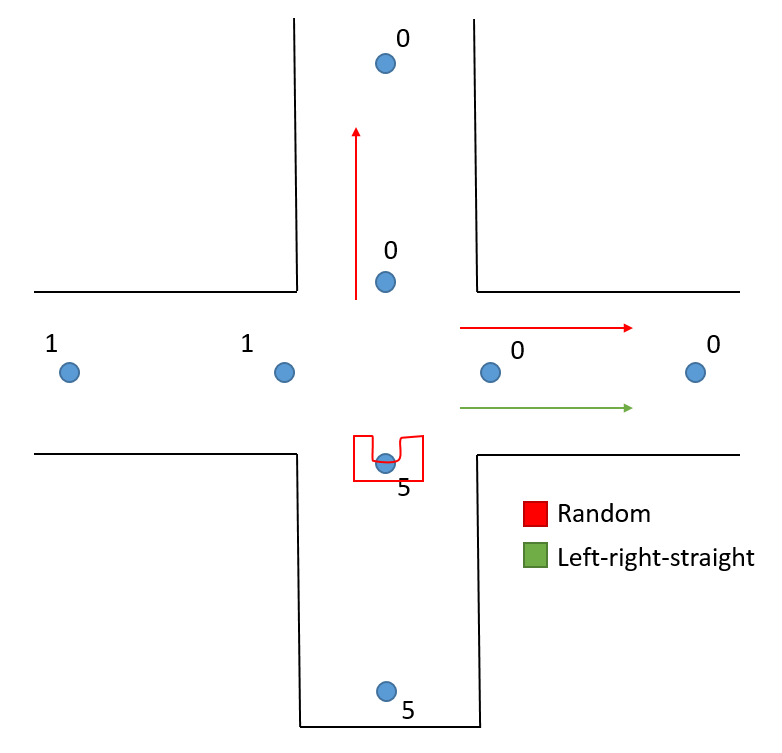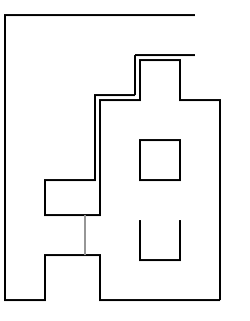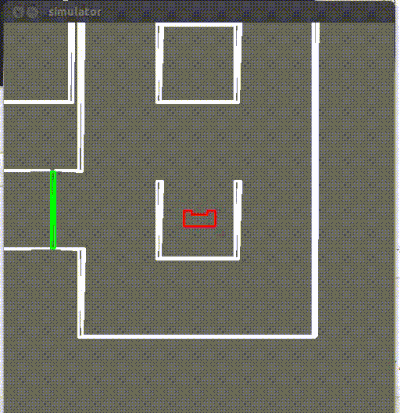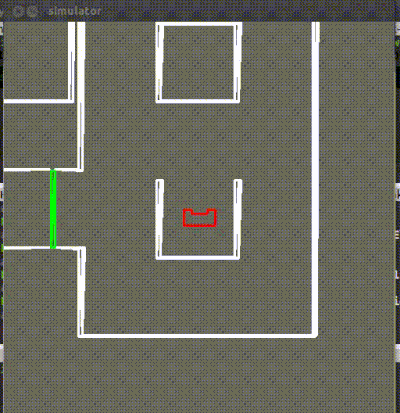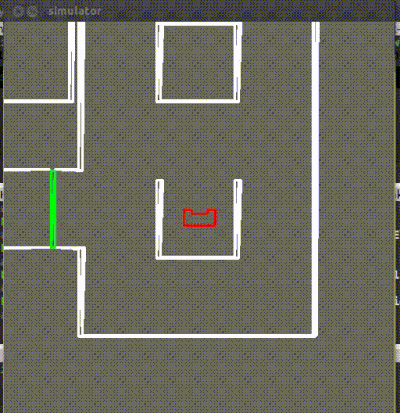Embedded Motion Control 2016 Group 7
Group Members
| ID-Number | Name | |
| 0816253 | Emile van Halsema | e dot v dot halsema at student dot tue dot nl |
| 0805999 | Nard Strijbosch | n dot w dot a dot strijbosch at student dot tue dot nl |
| 0816608 | Raymond Kerstens | r dot j dot c dot m dot kerstens at student dot tue dot nl |
| 0814199 | Frank Heck | f dot j dot m dot heck at student dot tue dot nl |
| 0816361 | Ids van den Meijdenberg | j dot w dot a dot v dot d dot meijdenberg at student do tue dot nl |
Final Design for Maze Challenge
Coordinator
The coordinator is the function that controls in what state the robot is and what state it should go. The states are placed in a switch-case with as variable the integer "state". There are several states: Setpoint reached, Driving, Possible door, No fit or setpoint, Stuck, Stuck driving and Reset.
Setpoint reached
In the setpoint reached state first a new rectangle fit is made out of the laser data. The fit is analyzed to determine the possible setpoints locally. Using the local distance to the setpoint that is reached and the angle of the main rectangle the odomotry can be updated. Next, the global mapping can be updated and a new setpoint can be determined using the mazesolver. If all goes as planned the state will be updated to the driving state. If not, the state will be updated to the No fit and setpoint state.
Driving
The driving state is build up with a big if else that checks for certain situations, such as recognition of a door or the reaching of a setpoint. If some situation occurs, the state variable will be changed to make sure that the robot will be in a new state to deal with the situation properly. If there is no special situation, the robot can drive using the potential field to make sure that the robot will not collide into a wall.
Possible Door
When a door is recognized and the robot is in front of the door, the robot will get into this state. In this state a new rectangle fit will be made. After beeping and waiting for 5 seconds, a new fit will be made. The length of the rectangle in front of the robot is compared in the two situations to determine if the door has been opened. If the door has been opened, the mapping is cleared and new nodes will be made. The setpoint at the door will be set to a high value to make sure that the robot will not return through the door unless it has run through the whole maze several times. Next the state will be updated to the Setpoint reached state to make a new fit and determine new setpoints. If the door has not opened, the door was no door but a dead end and the robot will turn around to continue its search for the door.
No fit or setpoint
In this state two situations are distinguished: having an unreliable fit or having no setpoint. If the fit is reliable, but there is no setpoint, the local point that is in front of the robot with the least distance to the robot will be set as new setpoint. If the fit is unreliable, the robot will put a new setpoint 20 cm further in the corridor in which the robot is standing.
Stuck
If the robot can not reach its current setpoint it will get into this state. If the robot has no official main setpoint, as made in the first state, the robot will immediatly go to the reset state. If the setpoint cannot be reached, a temporary setpoint in the middle of the intersection will be placed, which will be driven to in the next state.
Stuck driving
In this state the robot will try to drive to the temporary setpoint. Once this setpoint is reached, the robot will go to the normal driving state to try again to drive towards the original setpoint. However, if the temporary setpoint is not reached, the robot will go to the reset state.
Reset
In this state the robot will get once things have gone wrong. All the mapping will be deleted. Next a new fit will be made and a new setpoint will be determined. If the fit is unreliable or there cannot be created a setpoint, the robot will turn 0.5 radians and try again until it has succeeded to get a reliable fit and a setpoint. Once a setpoint is determined, the state will change to the driving state.
Environment identification
To subtract relevant information from the laser data an environment identification algorithm is used. This algorithm determines the dimensions of the corridor where pico is positioned, and it determines all the position and location of the visible sideroads. Using this information the world model can be updated, and the odometry data can be corrected.
General model
To be able to identify the environment a general model is proposed as shown in the figure to the right. The model consist of the current corridor, the corridor Pico is placed at the moment of the identification, and side roads at the west, north and east side of this current corridor.
The general model is parameterized relative to Pico. So the angle the current corridor as relative to Pico is described by \theta. The distance to the West and East walls are described with A and B respectively. To distance to the North and South are described with l and m respectively.
It is assumed that all the corridors are perpendicular to each other. Hence, each side road can be described with 3 parameters, the width (C), the length (D) and the location with respect to the current corridor.
The open spaces can be interpreted as a wide side road, which means a possible side road in an open space should be to overlap with the ‘side road’ connected to the open space.
Algorithm
The general algorithm consists out of the following steps
- Preprocess laser data
- Determine the dimensions of current corridor
- Determine location and dimension of side roads
- Determine reliability of the found dimensions
Preprocess laser data
First the laser data is preprocessed. The characteristics of the LRF are that in large gaps between points ‘Ghost Points’ occur. First these Ghost Points are filtered out on the basis that there are no points close to these points. Furthermore the algorithm does not need all the points from the laser data, therefore the points can be filtered such that a set of points that are really close to each other can be combined into 1 point. Using this only relevant points remain and the computation time of the algorithm increases.
Determine current corridor
Using the relevant data the dimensions of the current corridor are determined. This is done by maximizing the area of this corridor, with the LDR data as boundary.
Optimization problem formulation
The optimization problem can be formulated as
- [math]\displaystyle{ \begin{align} &\underset{x}{\operatorname{maximize}}& & f(x)=(A+B)\cdot(l+m)=(x_1+x_2)\cdot(x_3+x_4) \\ &\operatorname{subject\;to} & & e_i(x) \leq 0, \quad i = 1,\dots,n \\ &&& x_i \leq x_{max}, \quad i = 0, \dots,4 \\ &&& x_i \geq x_{min}, \quad i = 0, \dots,4 \\ \end{align} }[/math]
where
- [math]\displaystyle{ x_0=\theta }[/math], [math]\displaystyle{ x_1=A }[/math], [math]\displaystyle{ x_2=B }[/math], [math]\displaystyle{ x_3=l }[/math], [math]\displaystyle{ x_4=m }[/math]
- the objective function [math]\displaystyle{ f(x) }[/math] is defined by the area of the rectangle,
- [math]\displaystyle{ e_i(x) }[/math]the smallest distance of point [math]\displaystyle{ i }[/math] to the sides of the rectangle, hereby the error is positive if the point is inside the rectangle
- [math]\displaystyle{ n }[/math] are the number of points.
The upper and lower bound for the design variables are chosen such that the dimensions of the rectangle stay realistic. It is assumed that Pico is positioned almost straight in the current corridor at the moment of the identification, therefore small upper and lower bounds are used for [math]\displaystyle{ \theta }[/math]
Initial conditions
Determine side roads
Optimization problem formulation
- [math]\displaystyle{ \begin{align} &\underset{x}{\operatorname{maximize}}& & f(x)=C\cdot D \\ &\operatorname{subject\;to} & & e_i(x) \leq 0, \quad i = 1,\dots,n \\ &&& x_i \leq x_{max}, \quad i = 1, \dots,3 \\ &&& x_i \geq x_{min}, \quad i = 1, \dots,3 \\ \end{align} }[/math]
where
- the objective function [math]\displaystyle{ f(x) }[/math] is defined by the area of the rectangle,
- [math]\displaystyle{ e_i(x) }[/math]the smallest distance of point [math]\displaystyle{ i }[/math] to the sides of the rectangle, hereby the error is positive if the point is inside the rectangle, and
- [math]\displaystyle{ n }[/math] are the number of points.
Initial conditions
Determine reliability
Implementation using dlib
Mapping
In the environment identification the current corridor and side roads are found relative to PICO. This can be translated to directions relative to PICO and positioning error relative to PICO. This is calculated in Local direction recognition. With the current location and orientation of PICO the directions relative to PICO can be rewritten to global directions from the origin. The mapping is build on the fact that the maze consists of crossings and turns. Each crossing consists of directions pointing away from the crossing. As the maze is axis aligned, all directions point either North, West, South or East. A crossing can thus be represented by multiple directions, which belong to the same intersection. A corner can be represented by two directions belonging to the same intersection, and a dead end by a single direction belonging to a intersection. In order to connect crossings, corners and dead ends the directions have to be connected. Hence the maze is represented by nodes(intersections) and edges(connected nodes) which in turn results in a undirected graph. In order to store the maze the position, orientation, intersection (number), connected direction are saved for each node together with the direction ID (which is used also for the connected direction) and the number of times that direction has been passed(which is used in the Maze solving algorithm later).
Local direction recognition
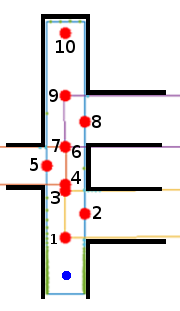
To determine local directions (the directions that PICO sees and are defined relative to PICO) the dimensions of the side roads outputted by the Environment identification are used. First it is checked whether the side roads are smaller than the maximal corridor width (1.5m). When they are smaller they will be processed as a corridor, when they're bigger as an open space. Next for all corridors the location and orientation of the direction is determined. This is the location at the crossing the current corridor(where PICO is located) in the middle of the side road that points away from the side road. In addition the furthest and closest point of each corridor is saved to distinguish separate crossings later.
A new local crossing is created and the closest and furthest point of that crossing are determined by checking when the different corridors start and end. In addition the beginning and ending widths are determined which are dependent on the presence of open spaces. All corridor directions that belong to the current local crossing are added to the list of local directions. If the crossing is in front of PICO an additional direction is added that points towards behind PICO and is located at the beginning of the crossing. If the current corridor(where PICO is located) continues after the crossing an additional direction is added that points forward and is located at the end of the crossing. A new local crossing is created and the above process repeated until all corridors are processed.
When there are no corridors left for processing the the current corridor is checked if it is a dead end. If it is a dead end then an additional direction is added with a margin from the wall, pointing away from the wall.
In the example on the right PICO is facing forward. From the results of the optimization there is a current corridor, and three side roads. Since all side roads start after the previous is finished there are 3 crossings. An additional crossing is added for the last direction belonging to a dead end. The first three directions belong to the first crossing, direction 4, 5 and 6 belong to the second crossing, direction 7(which is on the same location as direction 6), 8 and 9 belong to the third crossing and direction 10 belongs to the fourth crossing. All directions point away from the crossing.
Depending on whether the local direction recognition is called in a crossing or in a corridor it calculates the position of the end or the beginning of the first crossing. As this function is only called when a setpoint is reached this is a method to verify if PICO is on that setpoint. That location is later used to correct the odometry data.
Global mapping
The local directions are then implemented in the global mapping and connected. To achieve this the old mapping is required, along with the local directions and the actual position and orientation of PICO.
The global mapping first saves the current global direction PICO is located if it is not connected to another node yet. For the first crossing the local direction pointing towards behind PICO is saved. If there is a local directions pointing forward and the crossing is not the last local crossing then the direction is saved as well. These are used later to connect the directions. For all directions in the current crossing all coordinates and orientations of the local directions relative to PICO are converted to be relative to the origin and then checked with all directions already in the global mapping to find matching pairs. If the local direction matches a global direction, the ID of the global direction is saved along with the crossing ID. If one direction of the local crossing is matched to a global crossing, then all local directions of that local crossing can be added to that global crossing(if they do not correspond to a global direction yet), if there is no match, then a new crossing is created where all local directions will be added. For the direction that points behind PICO it is checked wether the corresponding global direction is not connected yet. If that is the case it will be connected to the first known direction that points forward from PICO that is not matched yet(for the first direction this would be the current direction PICO is located). If there is a direction that points towards forward from PICO, and the corresponding global direction is not connected yet, this global direction is added to the list of known directions that point forward from pico that are not mached yet. This is repeated for all local crossings.
The directions that are to the gobal mapping are saved and along with the earlier matched directions they make the visible directions
Mazesolver
The mazesolver makes use of the nodes which are created in the mapping. The coordinator decides when the mazesolver is ran. When the mazesolver runs it first checks if Pico is in a corridor or on an intersection. If Pico is in a corridor it looks in the list of known nodes and checks if there exists a node that is connected to the current node. If so the mazesolver will return the position of this node. Else the mazesolver will tell the coordinator that there is no connected node (the coordinator will then drive forward and try to find new nodes again). The mazesolver makes use of the Trémaux’s algorithm, when Pico reaches a node it will update the number of times Pico passed that node and it will always select the path where Pico has been the least. A dead-end is marked by updating the number of passes to 5, this way Pico will only try a dead-end once.
If Pico is on an intersection it will select the direction which Pico has passed the least. If there are multiple possible least passed directions it will select the new direction in the following order: left-right-straight. There is also a setting (which can be changed in the magic parameters) which changes the selection of the least passed direction to random.
Furthermore the mazesolver lets the coordinator know when Pico is in a dead-end and thus there is a possible door.
Maze challenge Attempts
On 8 juni 2016, the final Maze challange was held at the RoboCup soccer field. In total, 7 groups implemented their code on PICO to see which group was able to finish the maze. Each group had two attempts at solving the maze. The maze is depicted below and as one can see consists of multiple dead-ends, one loop, a rather tricky placed door, and an open-space. The starting position was the U-shaped corridor in the bottom of the figure. The open-space was located behind the door. At the end of the open-space, the exit was located. Below, the two attempts are discussed together with the results and a video of the challanges.
Attempt 1
Below, a YouTube-link to the first attempt of the Maze challange at the RoboCup soccer field can be found. For the first attempt, the Mazesolver introduced a preference with respect to which direction PICO should go at an intersection. When PICO approaches an intersection, the first preference is to the left, the second preference to the right and else PICO should go straight.
https://www.youtube.com/watch?v=8nTIp-3s3bo
It is observed that the initialisation is executed correctly, since PICO correctly fits the rechtangles and goes to the left at the initial intersection. Afterwards, PICO recognizes the second intersection and decides to go to the left again. Unfortunately, due to the unlucky placement of the door PICO did not recognize the intersection including the door. Therefore, PICO drives forward and goes to the left afterwards. Due to the preference to the left, PICO drives back to it's starting position. However, the Tremaux algorithm ensures that PICO does not visit places where it already have been. Therefore, it goes to the right at the intersection, hence it can be concluded that the mapping was executed correctly. Unfortunately, PICO detects a dead-end which results in a turn-around. This is due to the fact that the rectangle fit does not 'see' the corridor to the right, and therefore marks the corridor as a dead-end. Subsequently, PICO drives to the starting position. From then on, PICO starts panicking and undesired actions are happening resulting in a collission with the wall. The problem of the wrongly detected dead-end could be fixed by implementing a certain trust region in the local node recognition. That is that only in a certain region around PICO, local nodes should be recognized. However, this re-adjustment will have consequences for the rest of the code and therefore was not implemented easily during the Maze challange.
Attempt 2
Below, the YouTube-link to the second attempt of the Maze challange can be found. Since the first attempt was not succesfull, another method of the Mazesolver was implemented. This time, PICO randomly chooses a direction to go when PICO is at an intersection. Maybe PICO was now able to atleast find the door and open it.
https://www.youtube.com/watch?v=J7_U3Ru8vq4
From the video, it is observed that again the initialisation phase was succesfull. Note that this time PICO randomly chooses to go to the right at the second intersection. Unforunately, PICO again approaches the door from the side for which is it difficult to recognize the door. From that on, PICO start panicking again and does undesired actions. However, PICO was able to reset hisself resulting in a clean slate resulting in correctly taking turns. Sadly, PICO again recognizes a dead-end due to the fact that one side-road is not fitted correctly. Therefore, PICO turns around. After multiple can find the door and is able to open the door, although a little bit of luck was needed. Unfortunately, PICO did not enter the open-space and was therefore not able to finish te Maze.
Simulation
Overal Conclusion
Conclusion
During this group-project we learned a lot regarding coding in C++, but also using a compact code architecture. It turned out that our approach was different and unique compared to all other groups. The rectangle fit idea was worked out and used as one of the main functions used for other code components such as local node recognition and the mapping. Although the rectangle idea seemed wonderfull on the first hand, there are some drawbacks. One of the biggest drawback is that the local node extraction is complex to implement. Furthermore, the odometry correction should have been implemented in a different manner since the current odometry correction was not reliable enough due to the low update rate. It appears that there is always room for improvement. Furthermore, programming in C++ was a new experience for most of us. The EMC environment provided on Ubuntu gave us the tools to develop our program skills, and gave us hand on experience of embedding the code on an actual robot which was really great. To conclude, the biggest lessons learned during this project are:
- The effectiveness of a coordinator
- When the main file is explicitly separated in multiple files, the structure from the composition pattern is easier to understand
- Simulation does not guarantee correct performance during experiments
- Start with a correct model-formulation before writing C++ code
- Start easy
- Make sure that the magic parameters are defined to ensure that the code is easily scaleable
- How to ensure robustness and take undesired behaviour into account
Recommendation
As mentioned earlier, there is always room for improvement. When we had some more time to improve, the following aspects could be improved:
- Odometry correction: as mentioned earlier, the current implementation is not reliable enough to ensure proper correction. Therefore, another method should be implemented, preferably using the rectangle fits.
- Local node recognition: the current node recognition works fine, however there is still room for improvement. During the Maze challange it appeared that the trust region of the local node recognition should be lowered to ensure that corridors are not characterised as dead-ends.
- Visualisation: it is always nice to have some fancy visual aids which can be used for debugging. For example, the vectors of the potential field could be represented.
Files
Initial Design: File:Initial design.pdf
Presentation of task-skill-motion system architecture: File:System architecture Presentation Group 7.pdf
Presentation of final design: File:Final design.pdf

